CALIFORNIA
STREAMSIDE
BIOSURVEY DATA WORKSHEET
(make multiple copies of this blank data sheet, one for each
sample)
|
Date
|
Stream
|
Location
|
Sample No.
|
|
Stream Type Sampled:
o
Rock-bottom Riffle
o
Mud-bottom Channel (circle substrates sampled: wood / bank / plants /
bottom sediment)
INVERTEBRATE
INDICATOR GROUP COUNTS:
#
= Counts (actual number counted in each group, out of a minimum 100 total)
A
= Abundance category (R = rare <5%; C = common 5-25%; D = dominant >25%)
S
= Index Score (from Table of Index Scores)
|
#
|
%
A
|
S
|
Sensitive
Category I
|
|
#
|
%
A
|
S
|
Intermediate
Category II
|
|
#
|
%
A
|
S
|
Tolerant
Category III
|
|
|
|
|
___
|
|
Mayflies
|
|
|
___
|
|
Riffle Beetles
|
|
|
___
|
|
Midges
|
|
|
|
|
___
|
|
Stoneflies
|
|
|
___
|
|
Netspinning
Caddisflies
|
|
|
___
|
|
Black Flies
|
|
|
|
|
___
|
|
Caddisflies
(w/o netspinners)
|
|
|
___
|
|
Alderflies
|
|
|
___
|
|
Dragon- or
damselflies
|
|
|
|
|
___
|
|
Hellgrammites and (Dobson -
Fishflies)
|
|
|
___
|
|
Crane Flies &
Other Diptera
|
|
|
___
|
|
Leeches
|
|
|
|
Sum
Score
|
|
|
|
|
___
|
|
Other
Water Beetles
|
|
|
___
|
|
Snails
|
|
|
|
|
|
|
|
|
___
|
|
Flatworms
|
|
|
___
|
|
Clams
|
|
|
|
|
|
|
|
|
___
|
|
Other/Unknown
Invertebrates
|
|
|
___
|
|
Scuds
|
|
|
|
|
|
|
|
|
Sum
Score
|
|
|
|
|
___
|
|
Segmented
Worms
|
|
|
|
|
|
|
|
|
|
Sum
Score
|
|
|
|
|
|
|
|
|
|
|
|
|
|
|
|
|
|
|
|
|
|
|
|
Biological Index of Water Quality
= [Sum
Scores of categories I + II + III ]
Water Quality Rating [ ]
(see Rating Table)
Comparison to Reference Biol. Index [
]
Total Number # Groups Counted (all categories) = ______
SCI (sequential comparison index for n=50) = ____
Measures
of water quality (if test kits available):
|
Temperature
|
Dissolved Oxygen
|
Alkalinity
|
Turbidity
|
Other?
|
|
|
|
|
|
|
Appearance of
water:
clear
turbid
foam
oils
greenish
Description
of other surrounding environmental features such as
landscape and land:
INVERTEBRATE PICTURE KEY
from The California Streamside Biosurvey by Herbst,
Feng, and Gregorio
I.
SENSITIVE CATEGORY
|
Mayflies
Insect
order Ephemeroptera
Usually
have 3 tails, gills on abdomen, and feed on algae or
organic particles (detritus).
Size:
Usual- 5-10 mm,
Range- 2-15 mm
|


|
|
|
Stoneflies
Insect
order Plecoptera
Two
tails, gills on thorax but not abdomen.
Large predators and small detritovores.
Size:
Usual- 10-20 mm,
Range- 5-30 mm
|

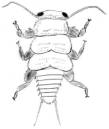
|
|
|
Caddisflies
Insect
order Trichoptera
Usually
construct a case but may be without, and commonly
feed on detritus or algae.
Size:
Usual- 5-10 mm,
Range- 2-25 mm
|
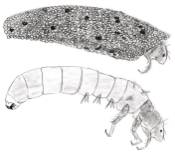

|
|
|
Hellgrammites
(fishflies or dobsonflies)
Insect
order Megaloptera, Family Corydalidae
The
larvae are large and active predators, with dark
heads and long gills along the abdomen.
Size:
Usual- 20-30 mm,
Range- 10-70
mm
|
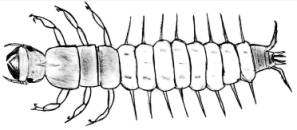
|
|
II.
INTERMEDIATE CATEGORY
|
Riffle
Beetles
Insect
order Coleoptera, Family Elmidae
Adults
& larvae of these small stout beetles are
dark brown, and feed on detritus & algae.
Size:
Usual- 3-5 mm,
Range- 2-10 mm
|
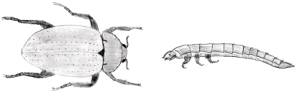
ADULT
LARVA
|
|
|
Net-Spinning
Caddisflies
Order
Trichoptera, Family Hydropsychidae
These
caddisflies attach their case to rocks and
spin a net to capture fine particle food.
Size:
Usual-
5-10 mm,
Range- 3-15 mm
|
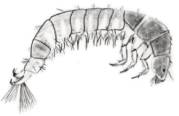
|
|
|
Alderflies
Order
Megaloptera, Family Sialidae
Medium
size predators with gill filaments on the
sides and tip of abdomen.
Size:
Usual- 5-15 mm,
Range- up
to 25 mm
|
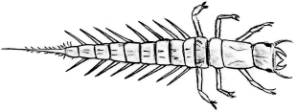
|
|
|
Crane
Flies (and other Diptera)
Insect
order Diptera, Family Tipulidae
Larvae
maggot-like, segmented, gills at hind
end finger-like, often feed on detritus.
Size:
Usual- 5-10
mm,
Range- up to 50 mm
|

|
|
|
Other
Water Beetles
(Order Coleoptera)
Families
Dytiscidae & Hydrophilidae
Adults
are active swimmers, both adults and
larvae are predators or scavengers.
Size:
Usual 3-10 mm,
Range- 2-30
mm
|


ADULT
LARVA
|
|
|
Flatworms
(Class Turbellaria)
Order
Tricladida (commonly Planarians)
No
segments, often darker above and
lighter below, predators and
scavengers.
Size:
Usual- 5-10 mm,
Range- 3-20 mm
|
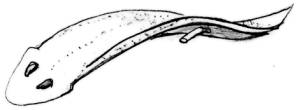
|
|
|
Other
/ Unknown Invertebrates
Includes
mostly rare taxa of insects and
non-insects but should be counted.
|
NO PICTURE
|
III. TOLERANT
CATEGORY
|
Midges
Insect
order Diptera, Family Chironomidae
Small
fly larvae, often feed on fine
particles.
Size:
Usual- 2-4 mm,
Range- 1-10 mm
|
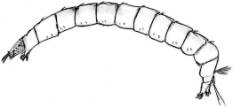
|
|
|
Black
Flies
Insect
order Diptera, Family Simuliidae
Hourglass
body-shape, particle
filter-feeder.
Size:
Usual- 4-8 mm,
Range- 2-12 mm
|

|
|
|
Dragon-
and Damselflies
Insect
order Odonata
Stout-bodied
predators with extendable
jaws.
Size:
Usual- 10-15 Range-
5-40 mm
|


|
|
|
Leeches
Class
Hirudinea
Body
flattened, segments &
sucker, predators.
Size:
Usual- 10-20 mm,
Range- 5-40 mm
|

|
|
|
Snails
Class
Gastropoda
Turban/
spiral-shaped shell, feed
on algae.
Size:
Usual- 5-10 mm,
Range- 2-20 mm
|

|
|
|
Clams
("fingernail")
Class
Bivalvia, Family
Sphaeriidae
Shells
speckled black / white,
feed on detritus.
Size:
Usual- 2-5 mm,
Range- 2-15 mm
|

|
|
|
Scuds
("sideswimmers")
Crustacean
order Amphipoda
White-yellow,
flat, many legs,
varied food.
Size:
Usual- 4-8 mm,
Range- 2-12 mm
|
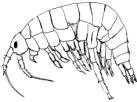
|
|
|
Segmented
Worms
Class
Oligochaeta
Round
body many segments,
feed on detritus.
Size:
Usual- 3-10 mm,
Range- up
to 50 mm
|

|
|





















